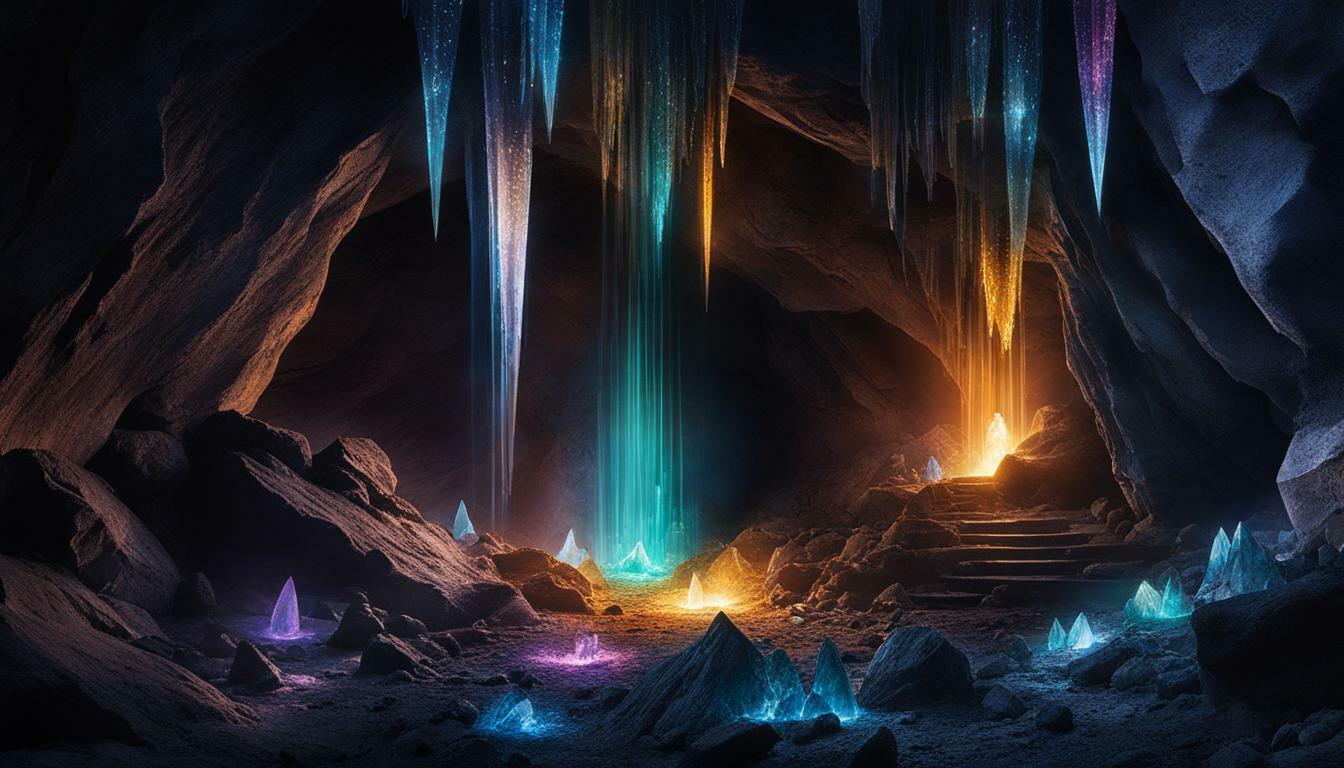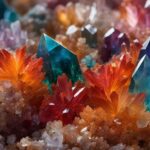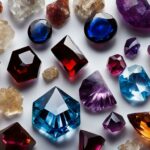Have you ever wondered which crystals have the enchanting ability to glow in the dark? These luminescent gems captivate our imagination with their ethereal glow, creating a mystical and captivating ambiance. Some may call it magic, but the science behind these crystals is equally fascinating.
Crystals that emit light in the dark are known as glow in the dark crystals or phosphorescent crystals. This phenomenon occurs due to the fluorescence property of certain minerals. When exposed to ultraviolet (UV) light, these crystals absorb the light energy and then re-emit it as visible light, creating a mesmerizing glow.
Key Takeaways:
- UV reactive crystals emit light in the dark due to their fluorescence property.
- Popular crystals that glow in the dark include ruby, fluorite, aragonite, selenite, and apatite.
- The fluorescence of crystals can vary depending on the type of UV light used, such as longwave, midwave, or shortwave.
- UV light can be used to authenticate gemstones, as different gemstones exhibit distinct fluorescent properties.
- Not all crystals and gemstones exhibit fluorescence, and the intensity and color of the glow can vary.
Understanding Fluorescent Properties of Crystals
Crystals that glow in the dark possess unique fluorescent properties that make them a captivating sight to behold. This fascinating phenomenon occurs due to the presence of certain minerals within the crystal structure. When exposed to specific light wavelengths, these minerals absorb the energy and excite the electrons, causing them to jump to higher energy levels. As the electrons return to their original state, they release energy in the form of visible light, producing the mesmerizing glow.
This fluorescence property varies from crystal to crystal, with each mineral exhibiting distinct characteristics. Some crystals emit a soft, luminous glow, while others shine brightly, illuminating their surroundings. Popular examples of fluorescent crystals include ruby, fluorite, aragonite, selenite, and apatite. These crystals are renowned for their ability to radiate light even in the darkest of environments.
The intensity and color of the glow can be influenced by the type of UV light used. UV light is classified into three categories: longwave, midwave, and shortwave. Each type of UV light emits a different range of wavelengths, which can affect the fluorescence of crystals. By experimenting with various UV light sources, one can uncover the hidden beauty of these luminous gemstones, each revealing its unique brilliance and color.
Understanding the Science behind Fluorescent Crystals
Fluorescent crystals owe their remarkable glow to the quantum mechanical phenomenon known as fluorescence. When UV light strikes the crystal, it excites the electrons within the crystal lattice, causing them to jump to higher energy levels. These excited electrons are unstable and rapidly return to their ground state, releasing the excess energy as photons of light. The emitted light, with a longer wavelength, is what creates the stunning glow that captivates our eyes.
| Crystal | Glow Color |
|---|---|
| Ruby | Red |
| Fluorite | Various colors |
| Aragonite | Blue |
| Selenite | White |
| Apatite | Green |
UV light not only reveals the beauty of these crystals but also plays a crucial role in gemstone authentication. Different gemstones exhibit unique fluorescent properties, which can help identify their authenticity. For instance, diamonds emit a bright blue-white light when exposed to UV light, while rubies glow red and emeralds exhibit a faint green glow. Gemologists and jewelry experts often rely on UV light to discern real gemstones from imitations, as the fluorescence patterns provide valuable clues about their origin and quality.
While not all crystals and gemstones possess fluorescent properties, those that do offer a breathtaking display of natural luminosity. The world of UV reactive crystals is a realm filled with wonder and enchantment, where science and beauty coexist harmoniously. So the next time you encounter a crystal that glows in the dark, take a moment to appreciate the extraordinary phenomenon that makes it shine bright.
UV Reactive Crystals: Exploring Their Brilliance
UV reactive crystals have the power to light up the darkness when exposed to ultraviolet (UV) light. This mesmerizing phenomenon occurs due to the fluorescence property of certain minerals, where specific light wavelengths excite electrons within the atomic structure of the crystal, causing them to emit light at a different wavelength. It’s like unlocking a hidden world of vibrant colors and ethereal glow.
When UV light hits these crystals, it triggers a reaction that produces a captivating display of luminosity. It’s as if they come alive, showcasing their unique brilliance. The intensity of the glow can vary depending on the type of UV light used, such as longwave, midwave, or shortwave. Each crystal has its own distinct color and radiance, creating a stunning visual spectacle.
Some of the most popular crystals that light up under UV light include ruby, fluorite, aragonite, selenite, and apatite. These gems possess a captivating ability to transform darkness into a radiant glow. Each crystal holds its own beauty, with ruby displaying a deep red glow, fluorite showcasing a range of vibrant hues, and selenite emanating a soft ethereal light.
Enhancing Their Beauty with UV Light
To fully appreciate the awe-inspiring luminosity of UV reactive crystals, many enthusiasts use UV light as a tool to reveal their hidden beauty. By illuminating these crystals with specific wavelengths of UV light, their colors intensify, and their glow becomes even more enchanting. It’s like watching a masterpiece come to life.
Crystals that emit light under UV are not only a marvel to behold but can also be found in various forms of art and jewelry. From breathtaking sculptures to stunning necklaces, these crystals are cherished for their exquisite fluorescence. The art of bringing out their beauty lies in understanding the intricacies of UV light and its impact on the crystals’ glow.
| Crystal | UV Glow Color |
|---|---|
| Ruby | Deep red |
| Fluorite | Vibrant range of hues |
| Aragonite | Glowing white |
| Selenite | Soft ethereal light |
| Apatite | Icy blue |
UV reactive crystals allow us to witness nature’s mesmerizing beauty in a whole new light, quite literally. Their ability to emit an enchanting glow under UV light adds an element of magic to the world of crystals. So next time you encounter these fascinating gems, don’t forget to let them bask in the radiant brilliance of UV light and experience their captivating glow.
Unveiling the Gems That Glow
Let’s shine a spotlight on some remarkable crystals that possess the magical ability to glow in the dark. These luminous treasures, also known as UV reactive crystals, captivate with their otherworldly radiance. Their fluorescence property causes them to emit light when exposed to UV light, creating a mesmerizing display.
One such enchanting crystal is the ruby. Known for its deep red color, the ruby glows with an intense red hue under UV light, showcasing its vibrant beauty. Another captivating gem is fluorite, which exhibits a wide range of colors and can emit a soft glow under UV light, transforming into a stunning display of luminescence.
Aragonite is yet another gemstone that possesses the ability to glow. This crystal, with its delicate, needle-like formations, glimmers with a soft blue glow when illuminated by UV light. Selenite, on the other hand, exhibits a subtle ethereal glow, creating an almost mystical aura. And lastly, apatite, with its transparent to translucent appearance, radiates a captivating blue glow under UV light, adding to its allure.
| Crystal | Glow Color |
|---|---|
| Ruby | Intense red |
| Fluorite | Various colors |
| Aragonite | Soft blue |
| Selenite | Subtle ethereal glow |
| Apatite | Captivating blue |
These glowing gems add a touch of magic to any collection or jewelry piece. Their ability to emit light under UV light not only showcases their beauty but also offers a unique and captivating experience. Whether you’re a crystal enthusiast or simply intrigued by the wonders of the natural world, exploring these UV reactive crystals unveils a world of enchantment and awe.
The Art of UV Light: Revealing Hidden Beauty
Discover the stunning world of luminous crystals as we explore the art of using UV light to illuminate their hidden beauty. UV reactive crystals, also known as fluorescent crystals, have the extraordinary ability to emit light when exposed to ultraviolet (UV) light. This captivating phenomenon occurs due to the fluorescence property of certain minerals, where specific light wavelengths excite electrons within the crystal’s atomic structure, causing them to emit light at a different wavelength.
When it comes to exploring the brilliance of UV reactive crystals, the use of UV light is essential. Different wavelengths of UV light, such as longwave, midwave, and shortwave, can impact the intensity and color of the crystal’s glow. By carefully selecting the appropriate UV light wavelength, one can reveal the mesmerizing fluorescence and intricate patterns within these luminous crystals.
In the world of gemstones, UV light plays a significant role in authentication. Different gemstones exhibit distinct fluorescent properties under UV light, making it a valuable tool for gemstone experts. For instance, diamonds emit a bright blue-white light under UV light, revealing their true beauty. Rubies, on the other hand, glow with a vibrant red hue, adding a touch of allure. Emeralds exhibit a subtle and enchanting green glow when exposed to UV light, showcasing their uniqueness.
Unlock the Secrets of Luminous Crystals
As you delve into the world of crystals that emit light, you’ll soon realize the vast diversity in their illumination. From the fiery glow of rubies to the ethereal radiance of selenite, each crystal offers a fascinating glimpse into the wonders of nature. Whether you seek to appreciate their beauty or utilize their UV fluorescence for authentication purposes, these luminous crystals are sure to captivate and leave you in awe of their hidden secrets.
| Gemstone | Color | Fluorescence |
|---|---|---|
| Ruby | Red | Glowing red under UV light |
| Fluorite | Variety of colors | Exhibits fluorescence in various shades |
| Aragonite | Colorless, white, yellowish | Emits bright blue-white light under UV light |
| Selenite | White, transparent | Glowing effect under UV light |
| Apatite | Yellow, green, blue, violet | Different colors of fluorescence under UV light |
Gemstone Authentication: The Power of UV
Unlock the secrets of gemstone authentication through the power of UV light, as different gemstones reveal their true colors. UV light has long been used as a tool to identify and distinguish between various gemstones, thanks to their unique fluorescent properties. When exposed to ultraviolet light, gemstones can emit different colors of light, providing valuable insights into their authenticity and quality.
One of the most well-known gemstones that reacts to UV light is the diamond. Under UV light, diamonds emit a bright blue-white light, known as fluorescence. This characteristic glow can help gemologists determine the origin and quality of a diamond. Rubies, on the other hand, display a striking red fluorescence, which can help verify their authenticity. Similarly, emeralds, known for their lush green hue, exhibit a faint green glow when exposed to UV light, further confirming their genuineness.
To harness the power of UV light for gemstone authentication, gemologists use specialized UV lamps that emit specific wavelengths of light. These lamps can produce longwave, midwave, or shortwave UV light, each affecting gemstones differently. By examining a gemstone under different UV wavelengths, experts can identify specific fluorescent patterns and color changes, providing essential clues about its identity and quality.
| Gemstone | Fluorescence Color |
|---|---|
| Diamond | Bright blue-white |
| Ruby | Red |
| Emerald | Faint green |
It is important to note that not all gemstones exhibit fluorescence, and the intensity and color of the glow can vary. Therefore, UV light serves as a valuable tool for gemstone professionals, providing additional evidence in the evaluation and authentication process. By understanding the unique fluorescent properties of gemstones, experts can unlock the hidden beauty and secrets held within these precious stones.
Conclusion
In conclusion, crystals that glow in the dark offer an awe-inspiring glimpse into the wonders of nature, revealing a world of extraordinary beauty and intrigue. These UV reactive crystals captivate our imagination with their ability to emit light, creating a mesmerizing display that adds a touch of magic to any environment.
Fluorescent properties, inherent in certain minerals, are responsible for this captivating phenomenon. When exposed to specific wavelengths of UV light, electrons within the atomic structure of these crystals become excited and emit light at a different wavelength, resulting in their luminescence. It is this intricate interaction between light and matter that brings forth the captivating glow of these crystals.
Some popular examples of crystals that glow in the dark include the exquisite ruby, the vibrant fluorite, the delicate aragonite, the ethereal selenite, and the enchanting apatite. Each of these crystals possesses unique properties that make them shine with their own special radiance when exposed to UV light.
Furthermore, the use of UV light not only reveals the hidden beauty of these crystals but also serves as a powerful tool for gemstone authentication. Different gemstones exhibit distinct fluorescent properties under UV light, allowing experts to distinguish genuine gemstones from imitations. For instance, diamonds emit a brilliant blue-white light, rubies glow with a captivating red hue, and emeralds exhibit a subtle green glow, imparting a sense of authenticity and value.
However, it is important to note that not all crystals and gemstones exhibit fluorescence, and the intensity and color of the glow can vary. Each crystal possesses its own unique characteristics and properties, enhancing their allure and making their glow a mesmerizing sight to behold.
Are There Any Crystals That Glow in the Dark and Cannot Be Put in Water?
There are certain crystals to avoid in water if they possess glow-in-the-dark properties. Although many crystals are safe in water, some should stay dry. These include phosphorescent crystals like strontium aluminate, as water exposure can diminish their glowing effect. So, it’s important to do your research before submerging any crystals in water.
FAQ
What are UV reactive crystals?
UV reactive crystals are crystals that glow in the dark under UV light. This phenomenon occurs due to the fluorescence property of certain minerals, where specific light wavelengths excite electrons within the crystal’s atomic structure, causing them to emit light at a different wavelength.
Which crystals glow in the dark?
Some popular crystals that glow in the dark include ruby, fluorite, aragonite, selenite, and apatite. These crystals possess the ability to emit light when exposed to UV light, revealing their mesmerizing brilliance.
How does UV light affect crystals?
UV light can be used to reveal the fluorescence and hidden beauty of crystals. Different types of UV light, such as longwave, midwave, or shortwave, can impact the intensity and color of the crystals’ glow, creating a captivating visual experience.
Can UV light be used to authenticate gemstones?
Yes, UV light can be a valuable tool in gemstone authentication. Different gemstones exhibit distinct fluorescent properties under UV light, allowing gemologists to identify and verify their authenticity. For example, diamonds emit a bright blue-white light, rubies glow red, and emeralds exhibit a faint green glow.
Do all crystals and gemstones exhibit fluorescence?
No, not all crystals and gemstones exhibit fluorescence. The ability to glow in the dark under UV light is specific to certain minerals and their atomic structures. Additionally, the intensity and color of the glow can vary from crystal to crystal.








